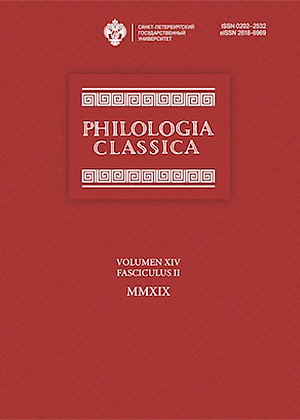“As Isis Loved Osiris, So Let Matrona Love Theodoros...”: Sympathetic Magic and Similia Similibus Formulae in Greek and Latin Curse Tablets (Part 2)
DOI:
https://doi.org/10.21638/11701/spbu20.2019.202Аннотация
In this contribution, we present a representative corpus of similia similibus formulae attested in ancient Greek and Latin curse tablets or defixiones. The simile formulae, attested in about 80 tablets in widely differing states of preservation and legibility, are introduced in the context of sympathetic magic and, in contradistinction to literary similes, as performative utterances that are based on a persuasive analogy. This analogy operates in the general form of “just as X possesses property P, so let also Y possess property P”, in which Y is the target or victim of the curse, while X and P are variables that change in accordance with the intended results. We provide a provisional taxonomy of simile formulae, offer new readings and interpretations of some defixiones, and compare Greek and Latin documents. Due to its length, the paper has been divided into two parts. In the first part, presented in the previous issue of Philologia Classica (Vol. 14, Fasc. 1, Pp. 27–55), we introduced curse tablets, briefly discussed the principles of sympathetic magic, and focused on comparata that reference the materiality of the tablet and comparata referencing corpses or ghosts of the dead. The remaining comparata, namely animals, historiolae and rituals, aversus formulae and unusual orientations of the script, “names”, and drawings, are presented in here together with general conclusions.
Ключевые слова:
curse tablets, defixiones, ancient magic, sympathetic magic, Greek and Latin epigraphy, similia similibus, simile formula, animals in antiquity, historiola
Скачивания
Библиографические ссылки
Dubosson-Sbriglione L. Le culte de la Mère des dieux dans l’Empire romain. Stuttgart, Franz Steiner Verlag, 2018 (Postdamer Altertumswissenschaftliche Beiträge 62).
Kalleres D. S. City of Demons: Violence, Ritual, and Christian Power in Late Antiquity. Oakland, CA, University of California Press, 2015.
Загрузки
Опубликован
Как цитировать
Выпуск
Раздел
Лицензия
Статьи журнала «Philologia Classica» находятся в открытом доступе и распространяются в соответствии с условиями Лицензионного Договора с Санкт-Петербургским государственным университетом, который бесплатно предоставляет авторам неограниченное распространение и самостоятельное архивирование.






